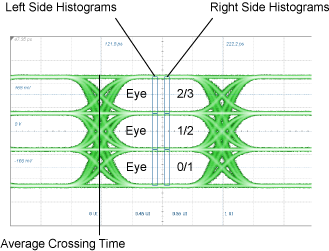Partial TDECQ
 The Partial TDECQ (Transmitter and Dispersion Eye Closure Quaternary) measurement measures the quality of an optical transmitter with its optical link. TDECQ is the optical power penalty of the measured optical transmitter compared to an ideal transmitter. It measures the increase of optical power required for the measured optical transmitter to achieve the same eye opening of the ideal optical transmitter. The lower the TDECQ measurement, the higher the quality of the measured transmitter. TDECQ is a PAM4 replacement for an NRZ Transmission Dispersion Penalty measurement.
The Partial TDECQ (Transmitter and Dispersion Eye Closure Quaternary) measurement measures the quality of an optical transmitter with its optical link. TDECQ is the optical power penalty of the measured optical transmitter compared to an ideal transmitter. It measures the increase of optical power required for the measured optical transmitter to achieve the same eye opening of the ideal optical transmitter. The lower the TDECQ measurement, the higher the quality of the measured transmitter. TDECQ is a PAM4 replacement for an NRZ Transmission Dispersion Penalty measurement.
The Partial TDECQ measurement actually performs three individual TDECQ measurements where each measurement is based on the contribution of a single PAM4 eye. So, TDECQ is reported for Eye 0, for Eye 1, and for Eye 2. This differs from the standard TDECQ measurement where a single measurement includes the contribution of all three eyes. By comparing the individual TDECQ contribution of each eye, you can gain additional insights into the causes of any measurement problems.
When the measurement is started, you're prompted to select a signal source and one of two vertical histograms on which to perform the measurement: Left or Right side. The location of these histograms is annotated on the displayed waveform. Like the standard TDECQ measurement, these two vertical histograms are located at 0.45 UI and 0.55 UI from the waveform's average crossing time as is shown in the following figure. The signal source should be the output of the TDECQ equalizer waveform signal processing operator. Refer to the standard TDECQ measurement for the steps required to run the measurement. Unlike the display for the TDECQ measurement, red pixels areas are not highlighted on the waveform.
